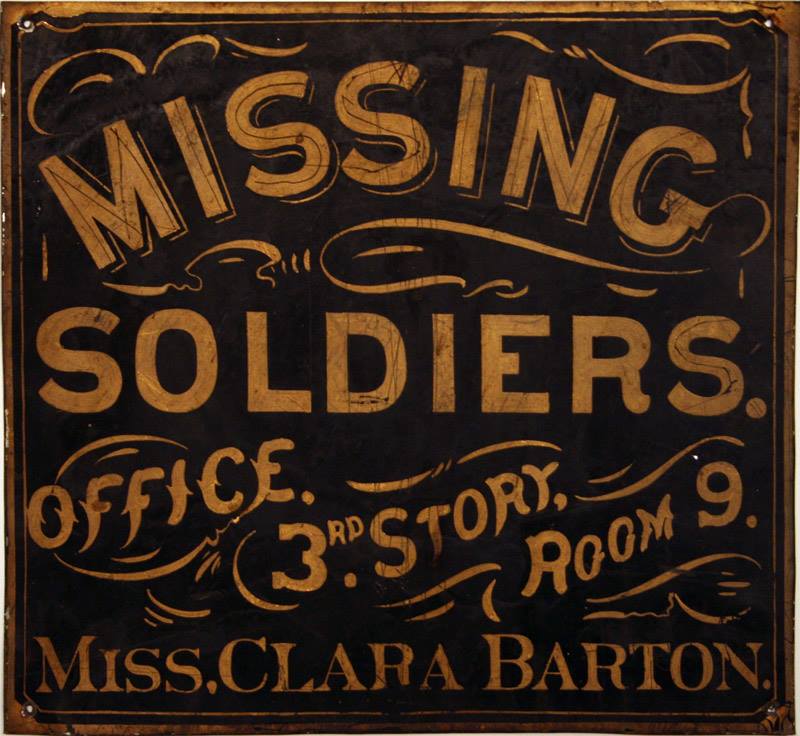“Please Examine this Roll” – Clara Barton’s Search for the Missing
As the Civil War started to draw to a close in early 1865, families wondered if their loved ones would come home. In an age before dog tags, it was not uncommon for unidentified soldiers to be buried in mass graves on battlefields far from home. Clara Barton had witnessed first-hand the destruction of Civil War battles from her time as a volunteer nurse. By 1865, the Union medical department did not have as great a need for volunteers to care for the sick and wounded, so Barton turned her attention to other ways she could help others.

Clara Barton (Courtesy of the Library of Congress)
On June 1, 1865, Clara Barton published the first “Roll of Missing Men” compiled by her Missing Soldiers Office. In an early crowdsourcing effort, this document was designed to spread a list of names of missing soldiers across the country so there would be a greater possibility that someone would recognize even one of the names on the list and contact her with information. On her Roll of Missing Men #1, Barton addressed a note to anyone reading the more than 1,500 names there listed.
Washington, D. C, June 1. 1865.
SOLDIERS AND BROTHERS: Please examine this roll; and if you know what became of any man here named, or have facts of interest to surviving friends, communicate the same to me by letter, as soon as possible, with your address in full.
If any one sees his own name, or that of a comrade whom he knows to be living, please inform me, that it may be withheld from future roll.
Letters of inquiry for missing soldiers may be brief should contain, the name, regiment company and State to which they belonged, with the full address of the writer, plainly written.
Attention will no longer be confined to those who have been prisoners, but an effort will be made to ascertain the fate of all missing men of the United States army during the war.
If any letter of inquiry fails to receive an answer, please write again. No apologies are necessary, and no letter will be neglected.
CLARA BARTON.
Address Miss Clara Barton, Washington, D. C.

Roll of Missing Men No 1
This substantial list of solders’ names garnered attention throughout the country, prompting a slew of newspapers to republish the“Rolls of Missing Men” across the nation.
THE DISCOVERY OF MISSING SOLDIERS. —
Miss. Clara Barton, a lady of intelligence and responsibility, whose address is Washington, D.C., has originated and efficient plan for discovering the whereabouts of missing soldiers to their friends. She writes to the public to send to her address in Washington a description of missing soldiers, giving the name, regiment, company and the State to which they respectively belong. In response, she has already received such descriptions of some thousands.
Roll No. 1 is a large sheet containing, we believe, about fifteen hundred names of missing prisoners of war. Twenty thousand copies of this roll have been printed and circulated all through the loyal States, and among the camps, and she now calls upon soldiers and others, who can give information concerning the missing men, to write to her immediately. Great care should be taken to write the name and address, in every instance, very plainly. Her plan is highly appreciated and approved by the War Department and the President.
The early work of the Missing Soldiers Office made people in the North more aware of all Clara Barton had done for soldiers throughout the war. Many had heard stories of her caring for wounded soldiers in the aftermath of Antietam, Fredericksburg, and other great battles, but her new project of searching for missing soldiers brought even more attention to her noble deeds. This widespread attention generated more names for the Missing Soldiers Office team to track down and helped create a public persona for Barton. She needed that notoriety. Her work during the Civil War of bringing much needed food and medical supplies to the front lines had nearly bankrupted her. If she was going to keep working to help others, she would need more resources. To address that need, a lecture tour across the country began later in 1865 in order for Barton to raise funds to continue the work of tracking down Union soldiers who disappeared during the conflict.

Original Missing Soldiers Office sign
Four more “Rolls of Missing Men” would be published by the Missing Soldiers Office and these documents were one of the most important ways the office communicated with the general public. Between the “Rolls of Missing Men” and the 60,000 letters the Missing Soldiers Office fielded, Barton and her team helped uncover the fates of more than 22,000 missing Union soldiers. And they helped elevate Clara Barton’s reputation in the eyes of the American public as a great humanitarian.
Want to learn more? Follow us on Facebook and Twitter to discover more stories from Civil War medicine!
Become a museum member and support our educational programs and research like this.
*Special thanks to our 2018 intern Ashley Bailey for her efforts to transcribe “The Discovery of Missing Soldiers” from the Clara Barton Collection at the Library of Congress
About the Author
Jake Wynn is the Director of Interpretation at the National Museum of Civil War Medicine. He also writes independently at the Wynning History blog.
Tags: Clara Barton, Clara Barton Missing Soldiers Office, Jake Wynn, missing men, Roll of Missing Men #1, Rolls of Missing Men Posted in: Uncategorized
